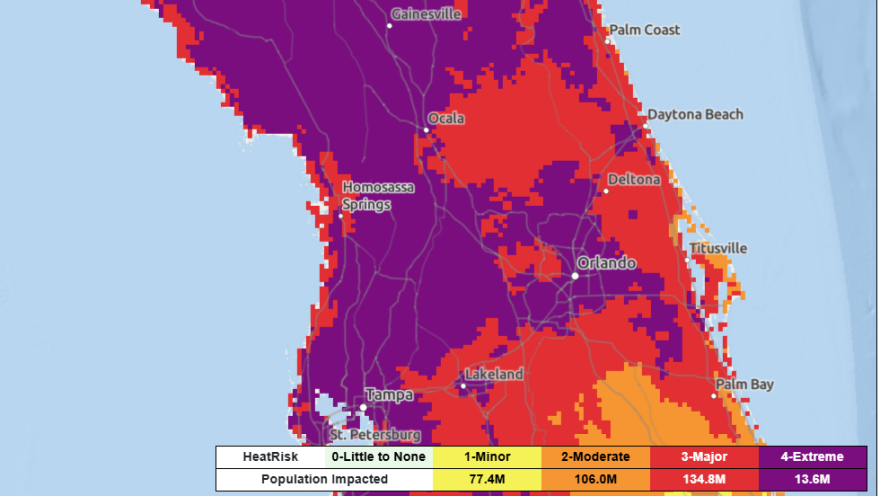Periods of extreme heat, like the highs this week in the upper 90s and low 100s, and heat indexes well over 110, are dangerous for people working outdoors.
The National Weather Service has issued an extreme heat watch for Tuesday in Marion County and heat advisories for all of Central Florida.
On Monday afternoon, the National Weather Service's interactive HeatRisk map showed much of Central Florida under extreme risk. About 13.8 million people, mostly in the southeastern U.S., are in the same category.
Tuesday's HeatRisk map looks much the same, with the extreme watch over South Georgia and central and north Florida.
The weather service explains the extreme risk: "Rare and/or long-duration extreme heat with no overnight relief affecting anyone without cooling/hydration as well as health systems, industries and infrastructure."

So the Farmworker Association of Florida is trying to get a safety message to both workers and policy makers.
That includes a series of social media posts raising awareness and providing health tips in English and Spanish.
Ernesto Ruiz, a researcher with the farmworker association, said the conditions right now are "brutal" in the fields and plant nurseries throughout Central Florida.
"[W]e're trying to let people know," he said, "community members and farmworkers themselves, as well as construction workers, landscape workers, so on and so forth, about symptoms, what to be on the lookout as far as heat stress, what steps they can take if they start to notice these symptoms, and what other steps they can take before and after they are in high-heat environments."
Ruiz said the long-term health impacts of the heat, including kidney disease, are serious. So is the impact on quality of life.
"Farmworkers report feeling exhausted, having excruciating headaches, having no energy, feeling anxious, going home and having no energy to play with their kids, to help them with their homework," Ruiz said. "They're just completely wiped out."
Last year, the Florida Legislature and Gov. Ron DeSantis passed a law (HB 433) that stripped local governments of the authority to protect workers from heat-injury or death.
Last summer -- the hottest on record for Florida -- the federal Occupational Safety and Health Administration proposed heat-related safety rules for people working indoors and outdoors. Those regulations are progressing through the approval process. Public hearings wrapped up this month.
The proposed rules include monitoring for heat illness, effective communication about heat risks, emergency response planning, training, hydration, rest breaks with shade or air conditioning, and acclimatization for workers new to the heat.
Protect yourself in extreme heat
When temperatures are extremely high, take steps to protect yourself and your loved ones:
- Stay in an air-conditioned indoor location as much as you can.
- Drink plenty of fluids even if you don't feel thirsty.
- Schedule outdoor activities carefully.
- Wear loose, lightweight, light-colored clothing and sunscreen.
- Pace yourself.
- Take cool showers or baths to cool down.
- Check on a friend or neighbor and have someone do the same for you.
- Never leave children or pets in cars.
- Check the local news for health and safety updates.
Source: CDC
Copyright 2025 Central Florida Public Media



